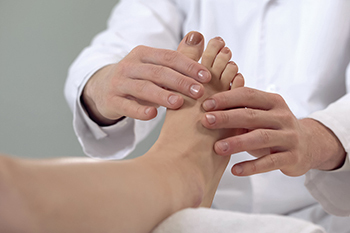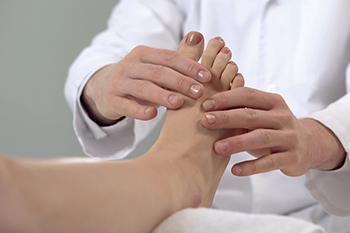Middlefield (860) 349-8500
Wallingford (203) 294-4977
Middlefield (860) 349-8500
Wallingford (203) 294-4977

Not surprisingly, a woman’s body changes dramatically over the course of her pregnancy, and as the body changes, the feet do as well. One notable change that can occur during a woman’s pregnancy is flat feet, the loss of the natural arch of the foot. Flat feet can develop as a result of the extra weight that a pregnant woman carries and/or changes in the body’s relaxin hormone. Further, when the arch of the foot flattens, a pregnant woman might also notice her feet roll inward when walking. This is known as over-pronation. To combat the effects of flat feet during a pregnancy, a woman may choose footwear that is specifically designed to provide ample support to the arches of the feet. Additionally, a pregnant woman might even wear orthotics to provide support when the natural arch is lost. If you are pregnant or are planning to become pregnant, consider making an appointment with a podiatrist who can advise you on changes to your feet during pregnancy.
Pregnant women with swollen feet can be treated with a variety of different methods that are readily available. For more information about other cures for swollen feet during pregnancy, consult with Dr. Gordon Fosdick from Affiliated Foot Care Center. Our doctor will attend to all of your foot and ankle needs.
What Foot Problems Can Arise During Pregnancy?
One problem that can occur is overpronation, which occurs when the arch of the foot flattens and tends to roll inward. This can cause pain and discomfort in your heels while you’re walking or even just standing up, trying to support your baby.
Another problem is edema, or swelling in the extremities. This often affects the feet during pregnancy but tends to occur in the later stages.
How Can I Keep My Feet Healthy During Pregnancy?
If you have any questions please feel free to contact our offices located in Middlefield and Wallingford, CT . We offer the newest diagnostic and treatment technologies for all your foot and ankle needs.

Baby’s feet are generally adorable, and you may yearn to touch them. They are soft and pliable as a result of the fatty tissue they are composed of. This will gradually convert into bone as the growing process occurs. Research has shown that babies are born with a stepping reflex, and this can be seen while they are held in a standing position as they move their legs as if they are walking. This will eventually disappear, and crawling will begin first, then walking will start at approximately one year of age. The majority of babies are born with flat feet, and the arch will be fully developed as they approach their teenage years. There are parents who choose to trim their baby's nails after they have had a bath, when the nails are the softest. An interesting fact is that baby’s feet will reach half of their adult foot size before they are one year old. Additionally, it is beneficial that the first shoes are made with a flexible sole, and padded ankle. This may be helpful in providing the necessary support as the first steps are taken. Please consult with a podiatrist if you would like to know more about what to expect as your child’s feet grow.
The health of a child’s feet is vital to their overall well-being. If you have any questions regarding foot health, contact Dr. Gordon Fosdick of Affiliated Foot Care Center. Our doctor can provide the care you need to keep you pain-free and on your feet.
Tips for Keeping Children's Feet Healthy
If you have any questions, please feel free to contact our offices located in Middlefield and Wallingford, CT . We offer the newest diagnostic and treatment technologies for all your foot care needs.

The ankle is a complex system of bones, tendons, and muscles that connect the leg and the foot. If any one of those elements is compromised, it may result in pain whenever you take a step. If you spend a lot of time running, walking or jumping, some type of pain in the ankle is not uncommon. Most ankle pain is the result of an injury to a muscle, tendon, or ligament. Ankle pain may also be caused by medical conditions, including arthritis, gout, or peripheral neuropathy. An injury, such as a ligament sprain, a muscle strain, or a fractured bone, will likely cause ankle pain and inhibit your ability to walk normally. Pain in the back of the ankle may be connected to an injury of the Achilles tendon. This can become torn, ruptured or inflamed, and severe cases may prevent you from putting any weight on the foot. If you are experiencing ankle pain when you walk, it is a good idea to consult a podiatrist for an exam and a diagnosis. An appropriate treatment plan can then be put into action.
Ankle pain can be caused by a number of problems and may be potentially serious. If you have ankle pain, consult with Dr. Gordon Fosdick from Affiliated Foot Care Center. Our doctor will assess your condition and provide you with quality foot and ankle treatment.
Ankle pain is any condition that causes pain in the ankle. Due to the fact that the ankle consists of tendons, muscles, bones, and ligaments, ankle pain can come from a number of different conditions.
Causes
The most common causes of ankle pain include:
Symptoms
Symptoms of ankle injury vary based upon the condition. Pain may include general pain and discomfort, swelling, aching, redness, bruising, burning or stabbing sensations, and/or loss of sensation.
Diagnosis
Due to the wide variety of potential causes of ankle pain, podiatrists will utilize a number of different methods to properly diagnose ankle pain. This can include asking for personal and family medical histories and of any recent injuries. Further diagnosis may include sensation tests, a physical examination, and potentially x-rays or other imaging tests.
Treatment
Just as the range of causes varies widely, so do treatments. Some more common treatments are rest, ice packs, keeping pressure off the foot, orthotics and braces, medication for inflammation and pain, and surgery.
If you have any questions, please feel free to contact our offices located in Middlefield and Wallingford, CT . We offer the newest diagnostic and treatment technologies for all your foot care needs.

A rare foot condition happens to only a few people in the population. Many rare foot conditions share symptoms with common foot problems but are harder to diagnose and treat. Three such foot diseases are Freiberg’s disease, Maffucci syndrome, and Kohler’s disease. Freiberg’s disease usually affects the second or third metatarsal bones and causes the bones to flatten and lose their normal, round, smooth shape. Symptoms include pain, swelling, and stiffness around the affected toe, and it can cause the forefoot to be tender and have a limited range of motion. Maffucci syndrome affects the skin and bones. It is characterized by multiple benign tumors in the cartilage, called enchondromas, which develop near the ends of bones and cause them to bulge and stop growing. These can lead to severe bone deformation and make bones more susceptible to fractures. This syndrome is most common among children and is rarely detected at birth, but symptoms can become apparent in the first few years of life. Kohler’s disease is another rare foot condition that happens due to the compression of the arch of the foot during a child’s early development. It affects boys more than girls and typically affects a single foot. Those with this disease have redness, swelling, and tenderness on the affected foot. Symptoms may be mild but chronic. If your child suffers from foot pain, see a podiatrist who can diagnose the problem and provide treatment.
Some foot conditions may require additional professional care. If you have any concerns, contact Dr. Gordon Fosdick of Affiliated Foot Care Center. Our doctor can provide the care you need to keep you pain-free and on your feet.
Rare Foot Conditions
The majority of foot conditions are common and can be treated by a podiatrist. Standard diagnostic procedures are generally used to identify specific conditions and treatment can be rendered. A podiatrist also treats rare foot conditions which can be difficult to diagnose and may need extra attention and care.
There are many rare foot conditions that can affect children. Some of these can include:
Freiberg’s disease - This can be seen as a deterioration and flattening of a metatarsal bone that exists in the ball of the foot. It typically affects pre-teen and teenage girls, but can affect anyone at any age. Symptoms that can accompany this can be swelling, stiffness, and the patient may limp.
Kohler’s disease - This often targets the bone in the arch of the foot and affects younger boys. It can lead to an interruption of the blood supply which ultimately can lead to bone deterioration. The patient may limp or experience tenderness, swelling, and redness.
Maffucci syndrome - This affects the long bones in a child’s foot leading to the development of abnormal bone lesions. They are benign growths and typically develop in early childhood and the bones may be susceptible to breaking.
A podiatrist can properly diagnose and treat all types of rare foot conditions. If your child is affected by any of these symptoms or conditions, please don’t hesitate to call our office so the correct treatment method can begin.
If you have any questions please feel free to contact our offices located in Middlefield and Wallingford, CT . We offer the newest diagnostic tools and technology to treat your foot and ankle needs.